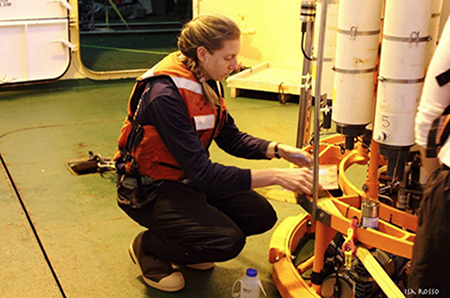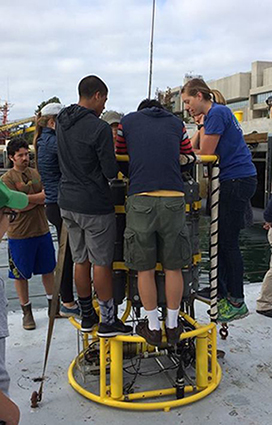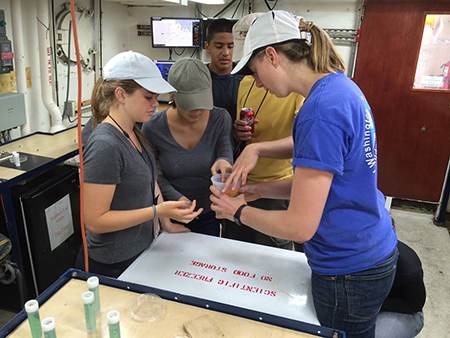When opportunity knocks, Veronica Tamsitt seems to always answer the door. So, when the University of Washington (UW) offered her a rowing scholarship, she traveled 8,000 miles from her home in Bungendore, Australia to join the Huskies. “I hadn’t decided what exactly I wanted to study at the time,” says Tamsitt, “something with science or engineering, something where I could use my hands.”
After getting settled at UW, Tamsitt heard the ‘tap tap’ of opportunity – “Oceanography for me happened a little by chance,” said Tamsitt, “the seniors had just been on a research trip to the Galapagos Islands, so I said, ‘sign me up!’ ”
For her own senior thesis, Tamsitt and her cohort went on a 10-day cruise off the coast of Mexico near the Oxygen Minimum Zone (OMZ). Tamsitt’s project focused on measuring nitrous oxide concentrations in the ocean and then estimating its flux into the atmosphere. “With no oxygen in the OMZ,” said Tamsitt, “microbes are breaking down nitrogen compounds, so these areas are real hotspots for nitrous oxide flux.”
After completing her undergraduate education, Tamsitt went straight into a PhD program at Scripps Institution of Oceanography at UC San Diego working with Professor Lynne Talley. Her dissertation work focused on three-dimensional deep ocean circulation in the Southern Ocean. “I ended up doing a modeling PhD even though don’t think of myself as a modeler,” said Tamsitt. “But there was an opportunity to use a data assimilation model to answer the questions I was interested in, so I took it.”

During her graduate work, Tamsitt sailed on an Ocean Observatories Initiative (OOI) cruise to the Southern Ocean Array from late 2015 into early 2016 to deploy biogeochemical Argo floats in the vicinity of the array. “You can’t just drop these floats in the water like regular Argo floats,” said Tamsitt, “you have to take water samples and calibrate them. We used water from the OOI CTD bottle samples to help with that calibration and deployed right by the surface mooring.”
To Tamsitt, the OOI is a game changer in conducting research in the Southern Ocean. “In the air-sea flux community, there are almost no measurements in the Southern Ocean except from ships,” said Tamsitt. “The OOI Surface Mooring is the southernmost mooring ever deployed, the only one out there other than south of Australia.”
Deploying next to the surface mooring provides an unprecedented opportunity to compare data across multiple platforms in this under sampled region. Additionally, since the surface mooring has a more comprehensive suite of carbonate sensors than the floats, researchers can get a more complete picture of the carbon cycle at that location and then extend that picture into the area covered by the floats. “My primary interest is air-sea fluxes of heat, but I am very excited by this carbon story,” said Tamsitt, “I hope that someone starts looking at those data soon too.”
The OOI cruise also happened to be Tamsitt’s first mooring deployment cruise. With her interest piqued, Tamsitt embraced the mooring data while on board and helped to validate it. She came away from the cruise with a brand-new dataset that no one seemed to be looking at yet–air-sea heat flux from the Southern Ocean Surface Mooring.
With the ocean taking up 90 percent of the excess heat humans are putting into the atmosphere and a lot of that heat removal occurring in the Southern Ocean, this is a key research area. “We have a really limited understanding of the direct exchange between the air and the sea there,” said Tamsitt. “So much so that often we don’t even know if heat is going in or out. The Southern Ocean is really the key to understanding net ocean heat uptake and how its changing.”

Even though these data were a side project to her main dissertation objectives, Tamsitt knew she could not pass it up. Over the next two summers, Tamsitt worked with an undergraduate student in the Talley laboratory, Sarah Ogle, from Carleton College in Minnesota as she analyzed the dataset. “We lucked out with Sarah, she was a San Diego native coming home every summer to help us on this project,” Tamsitt reflected.
The result of their effort was the first publication to use OOI data from the Southern Hemisphere, Ogle, et al. 2018, published in Geophysical Research Letters. “It was cool working on this publication because the Southern Ocean research community was so excited about it,” said Tamsitt. “It felt like everyone really cared about us publishing this work; showing just how valuable these data are.”
Having completed her dissertation at Scripps in March, Tamsitt is on to her next adventure, which happens to take her back to Australia as a postdoctoral scholar at the University of New South Wales and a member of the Center for Southern Hemisphere Ocean Research at the Commonwealth Scientific and Industrial Research Organisation in Hobart. “I hadn’t intended necessarily to move back to Australia,” said Tamsitt, “but this great postdoc came up, so of course I took it!”

For her post-doctoral work, Tamsitt will be comparing data from the OOI with the other Southern Ocean mooring, deployed southwest of Tasmania, the Southern Ocean Time Series Observatory (SOTS). Both moorings are in regions of deep water mixing and regions where water mass formation is really important for heat and carbon uptake, however, these regions differ greatly when it comes to El Niño. “By comparing these two moorings we are trying to understand how air-sea heat exchange and winter mixing are influenced by El Niño,” said Tamsitt.
Just as the location of those moorings was carefully planned and executed through hard work and determination, so has been Tamsitt’s career of ‘chance’ and ‘opportunity.’ “I guess I just don’t walk away from chances,” said Tamsitt. “I see that opportunity and say - I want to do that.”
A lot of this grit and persistence she credits to her training as an athlete. “At the time I felt like I was spending my whole life training,” she reflected, “but to be honest I feel like I have such good time management and self-discipline and sticking at things, just going at it. The work ethic you learn as an athlete really translates. I don’t think anything I did in my PhD is as hard as a two-kilometer rowing machine test.”

In terms of her next steps, Tamsitt is interested in continuing her research, but also sees the need to connect research to policy makers. After all, she did help develop a two-week intensive environmental science and policy course for high school students through the University of California San Diego Academic Connections – Global Environmental Leadership & Sustainability Washington DC.
Whatever direction she heads in, it is clear that Tamsitt’s future is going to have a lot of opportunities, and it is also clear that she is going to make the most of them.
– Leslie Smith, Ocean Observatories Initiative
Story adapted from an Ocean Observatories Initiative feature.